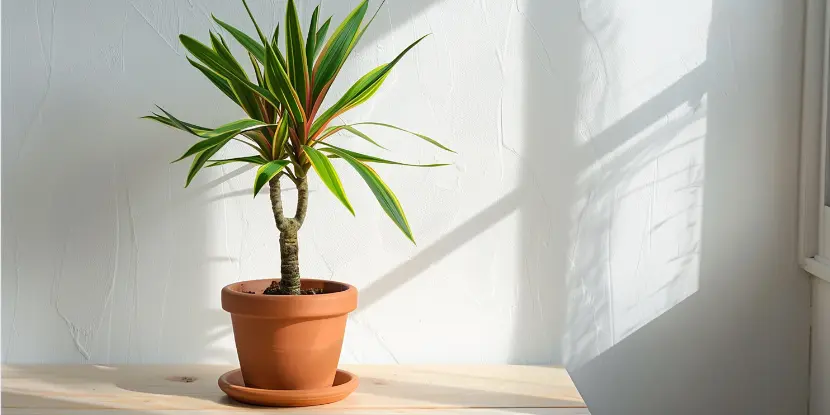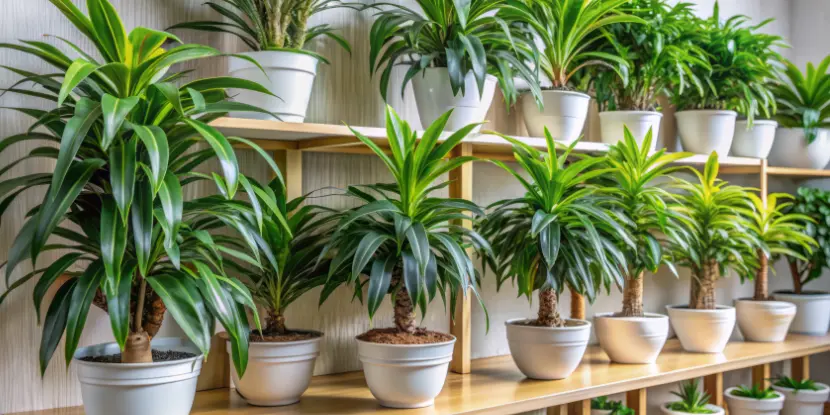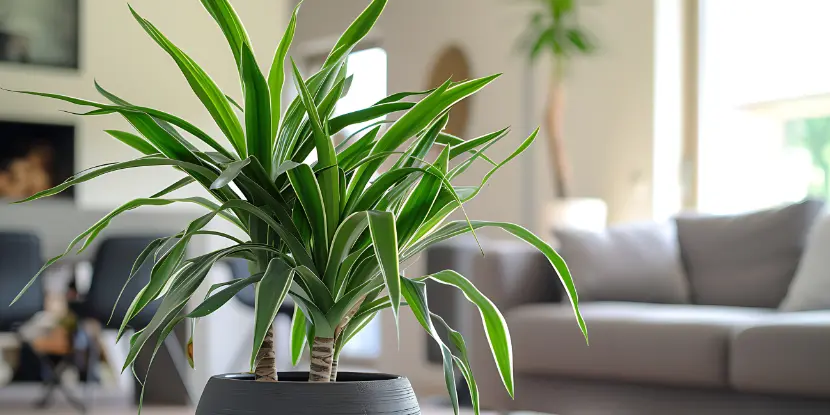Dracaena is a genus of flowering plants with more than 170 species, including some too big to be grown indoors. The name comes from the Greek word drakaina, the feminine form of “serpent”.
The plants trace back to Africa, Madagascar, and Southeast Asia, regions with warm climates and diverse ecosystems.
Dracaena ranges from small, bushy varieties to tall, tree-like specimens. The plants’ striking appearance and hardy nature make them a favorite among indoor gardeners worldwide.
Growing Dracaena Indoors
Popular Indoor Varieties
- Dracaena Marginata (Dragon Tree): Distinguished by its tree-like form and thin, arching leaves with red edges.
- Dracaena Fragrans (Corn Plant): Features broad, sword-shaped leaves and can grow quite tall. Use it to fill empty corners in your home.
- Dracaena Derricke (Lucky Bamboo): Often incorporated in feng shui design, Lucky Bamboo isn’t a true bamboo but can thrive in low light and prefers to be grown in water.
- Dracaena Janet Craig: Can withstand lower light conditions and is ideal for offices or rooms with limited natural light.
- Dracaena Gold Star: A compact variety with yellow and green striped leaves.

This bamboo-like plant is actually a Dracaena. Tricky!
Light Conditions
- Dracaenas thrive in bright, indirect light, like the light filtering through sheer curtains. Place your Dracaena near a window where it can soak up the sunlight without being scorched by direct rays.
- Dracaenas can tolerate low light conditions, though they might grow more slowly. Avoid the darkest corners of your home — the plants need a threshold light level to stay healthy.
Watering Wisdom: Less Is Better
Overwatering is the number one killer of death for Dracaena. If you’re unsure, keep them slightly on the dry side.
- Water your Dracaena thoroughly until you see water escaping from the drainage holes at the bottom of the pot. Then, let it drain completely. Never leave your plant in standing water.
- Water once every 1–2 weeks during the growing season (spring and summer). In the dormant months (fall and winter), you can cut back to every 3–4 weeks. If the top inch of soil is dry, it’s time to water.

Dracaena plants thrive in indirect sunlight. Never expose them directly to the sun’s rays.
Humidity: Keep It Moist, But Don’t Overdo It
- Give your Dracaena a light misting every few days, especially during the winter when indoor air is drier. This mimics the humidity of their natural habitat.
- Alternative: Place a tray filled with water and pebbles under your plant’s pot. As the water evaporates, it creates a humid microclimate around your Dracaena.
Soil & Potting: Finding The Right Mix
- A potting mix designed for houseplants usually works well. Add a little perlite or sand to improve drainage.
- Choose a pot slightly larger than the root ball of your Dracaena. If the pot is too large, the soil will retain too much moisture, which could lead to root rot.
Fertilizing Tips
- Use a balanced, water-soluble fertilizer every 4–6 weeks during the growing season. Dilute it to half-strength to avoid burning the roots.
- Skip the fertilizer during the dormant period. Let your Dracaena take a natural rest.

Some Dracaena plants are the size of small trees.
Pests & Diseases
Common Pests
- Spider mites can cause significant damage by sucking the sap from leaves. Watch for fine webbing and use a damp cloth to wipe them off. In severe cases, you can apply insecticidal soap or neem oil.
- Mealybugs appear as white, cotton-like masses. Remove them manually with a cotton swab dipped in rubbing alcohol, or treat the plant with insecticidal soap.
- Scale Insects manifest as small, brown bumps on stems and leaves. For tough infestations, scrape them off gently with a soft brush or cloth and apply a systemic insecticide.
Common Diseases
- Root rot results from overwatering. Ensure your Dracaena has proper drainage and allow the soil to dry out between watering. If root rot occurs, remove the affected roots and repot the plant in fresh, dry soil.
- Leaf spot causes brown or black spots on leaves. It may be due to overwatering or fungal infections. Prune affected leaves to prevent the spread and improve air circulation around the plant. Apply a fungicidal spray to manage more serious issues.

An indoor gardener’s dream: floor-to-ceiling Dracaena plants.
Propagation
- Take a healthy stem cutting approximately 6–8 inches long, ensuring it has several leaves. Cut with clean, sharp scissors or a knife.
- Place the stem cutting in water, or use a pot filled with a well-draining potting mix. If using water, replace it regularly to keep it fresh.
- Position the cutting in a warm area with bright, indirect light. Avoid direct sun exposure.
- Cover the cutting with a plastic bag or a humidity dome, ensuring it doesn’t touch the leaves. Remove the cover periodically to allow for air circulation.
- Once roots are 2–4 inches long (usually within 2-4 weeks), transplant the cutting into a container with a suitable potting mix, following the soil and potting guidelines outlined earlier.
- Water the newly potted cutting thoroughly and provide bright, indirect light, adjusting the humidity as needed to support growth.
Troubleshooting Common Dracaena Problems
Yellowing Leaves
- Overwatering: If the lower leaves turn yellow, it’s often a sign of overwatering. Check your watering routine and let the soil dry out more between waterings.
- Low Light: Yellowing can also occur if your plant isn’t getting enough light. Move it to a brighter spot and see if the problem resolves.
Brown Tips
- Low Humidity: Brown tips usually indicate the air is too dry. Increase humidity around your plant with a pebble tray or by misting more often.
- Fluoride Sensitivity: Dracaenas can be sensitive to fluoride in tap water. Consider using distilled or filtered water.
Drooping Leaves
- Underwatering: Your Dracaena may be telling you it’s thirsty. Give it a good drink; it should perk up within a few hours.
- Temperature Stress: Dracaenas don’t like extreme temperatures. Plants might start to sag if placed near a drafty window or in a spot with fluctuating temperatures.

A Dracaena plant enlivens a modern living room.
FAQs: Dracaena Care Indoors
Q: How can I make my Dracaena bushier?
You can prune the top of your Dracaena to encourage bushier growth. This will stimulate new growth from the sides, making your plant fuller.
Q: Can Dracaenas survive in low-light situations?
Dracaenas can tolerate low-light conditions, but their growth may slow, and the leaves might not be as vibrant.
Q: Is it safe to have Dracaena plants around pets?
Dracaena plants can be toxic to cats and dogs if ingested. Place them out of reach of pets or choose pet-safe alternatives.
Q: How often should I repot my Dracaena?
Typically, you should report your Dracaena every 1–2 years or when you notice the roots growing out of the drainage holes.
Q: What should I do if my Dracaena is growing too tall?
You can prune your Dracaena to control its height. Cutting back the stems to the desired length will also promote bushier growth.
Q: Why do my Dracaena’s leaves have spots?
Leaf spots can indicate overwatering, pest infestations, or fungal issues. Inspect the plant closely and adjust care as necessary.
Q: Can I grow Dracaenas outdoors?
Dracaenas flourish outdoors in warm, humid climates. However, they should be protected from direct sunlight and harsh weather conditions.
Q: How can I enhance the growth rate of my Dracaena?
Consistent humidity, adequate light, and regular feeding during the growing season can significantly enhance your Dracaena’s growth rate.
Q: What’s the ideal temperature range for Dracaenas?
Dracaenas prefer a temperature range of 65°F to 80°F (18°C to 27°C) and should be kept away from cold drafts and sudden temperature changes.
Q: How can I tell if my Dracaena needs more light?
If your Dracaena becomes leggy or the leaves lose their vibrant color, it may be time to provide more light.

